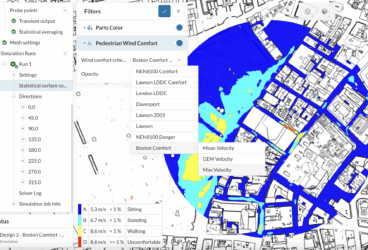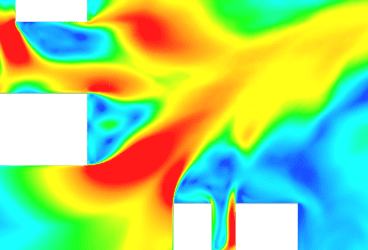Mott MacDonald is a global engineering, management, and development consultancy. Its purpose is to improve society by considering social outcomes in everything they do, relentlessly focusing on excellence and digital innovation, transforming clients’ businesses, communities, and employment opportunities. As a recognized global engineering firm with 135 offices in over 50 countries and 16,000 employees, Mott MacDonald constantly innovates a sustainable future for the built environment. Working on such varied and challenging projects, the software and tools Mott MacDonald uses are critical to ensuring the best designs are based on sound science and engineering principles. The application of computational fluid dynamics (or CFD software) is used to optimize the structure, shape, and overall design of complex buildings and structures.
Simulate and Adapt Cities for Climate Resilience:
A World Cities Day Event
“You just don’t get the same scalability working locally as you do when using cloud simulation in SimScale.”
Mott MacDonald

Mott MacDonald: Connected Thinking
Mott MacDonald’s focus is the “Big Issue” at the heart of the construction and infrastructure industry, globally; Sustainability! As a trend that is gaining more momentum, sustainable design is a significant factor for all built environment projects for Mott MacDonald, by maximizing the harnessing of natural resources, designing for a changing climate, and reducing the carbon footprint of the built environment.
Working across multiple sectors and industries and trying to embed sustainability requires an expert engineering and problem-solving capability. A key enabler is the use of simulation tools that allow collaboration between teams, accurate modeling of buildings and cities, and access to high-performance cloud computing. These are critical to scaling high-performing teams and capabilities across a global, multi-disciplinary firm like Mott MacDonald.
“Simulation is a major component of all projects as it allows us to predict outcomes in a more robust, time-efficient, and accurate way. Using simulation, and parametric models, allows us to test a larger set of design parameters and assess them against key performance indicators to select a preferred design. This provides a better outcome for the client.”
Ben Bleckly, Building Sciences Engineer at Mott MacDonald

Why is a simulation tool like SimScale so central to the projects at Mott MacDonald?
“The most important thing about sustainable building design is harnessing the climate. This includes designing to optimize the use of the wind, both the magnitude and direction, as well as the temperature.”
The Pedestrian Wind Comfort (PWC) app in SimScale is used to analyze a locations’ annual wind profile. The wind rose for a given place is generated in SimScale using the international meteoblue weather database and the latitude/longitude. This data is essential when trying to capture the wind for natural ventilation purposes as it shows you the most likely direction and frequency of wind speeds. It is then used to run a transient wind simulation to evaluate the impacts of a real wind on comfort and safety at the site. The same simulation is used to assess the potential for natural ventilation. Using customized wind profiles, it is possible to look at future climates to see the impact of more frequent storm events.
Simulation at Scale for Mott MacDonald
A recent project at Mott MacDonald involved assessing a sports stadium’s pitch health and internal patron comfort. In terms of pitch health, suppliers of turf provide a range of suitable wind speeds for their specific type of turf material. Typically, achieving these wind speeds through intelligent design and natural ventilation methods is significantly cheaper than trying to ventilate a stadium mechanically. This is where iterative CFD analysis methods can be beneficial.
A CFD simulation in SimScale, with multiple scenarios running in parallel, will allow an engineer to evaluate several design variants simultaneously. Mott MacDonald assessed the probability of exceeding certain wind speeds inside the stadium using CFD, which can help look at wind patterns across the turf that may affect gameplay. The results will show the impact of wind on an actual football (soccer) game and how it might adversely impact the ball’s movement in the air and, any wind forces on players that might be enough to cause imbalance. If, for example, the results showed that one end of the stadium was subject to higher wind speeds, it might cause a significant disadvantage to one team. This impact can be minimized through smarter design decisions that can mitigate excessive winds.
An outcome of the CFD analysis was to place louvres in two different locations to moderate, higher incident wind speeds at one end. By running many simulations, the louvre positioning was changed to highlight what impact moving them around can make on the coverage and wind speeds across the pitch. On the left image below, we can see an uneven distribution of wind speeds with a concentration on the south-west quadrant. On the image on the right, a more even spread across the entire pitch is observed. In these two examples, the first designs’ (left) top right corner still requires mechanical ventilation and is less sustainable. It will cost the client in the long run. The second design is more sustainable, and repositioning louvers using CFD analysis demonstrated this design’s comparative benefits.
Mott MacDonald Harnesses the Power of the Cloud
Mott MacDonald uses CFD to capture the environmental physics of complex structures and buildings. Spaces that are at the intersection of transport network design, building design, and urban planning, such as underground stations, for example. These types of areas lend themselves to CFD analysis as many unsteady effects of air movement are present. Similarly, large shopping malls, atriums, and semi-open spaces also fall into this category that requires computationally intensive simulations and collaboration to solve.
“Cloud servers are beneficial for extensive simulations as they can significantly decrease the time taken to run a simulation and, therefore, we can turnaround projects in a much shorter timeframe. In addition, we can run multiple simulations at the same which is not possible if we are trying to work from laptops or even a local machine. You just don’t get the same scalability working locally as you do when using cloud simulation in SimScale.”
Eugene Cullity, Mott MacDonald
Check out more SimScale resources for sustainable design:
- Thornton Tomasetti Develops a Digital Wind Tunnel App for Early-Stage Design
- Evaluating Design With BIM Modeling and Simulation
- Introducing CAD Editing in SimScale
- Net Zero Building Design & Cloud-Based Simulation
- Simulation for Sustainable Architecture



